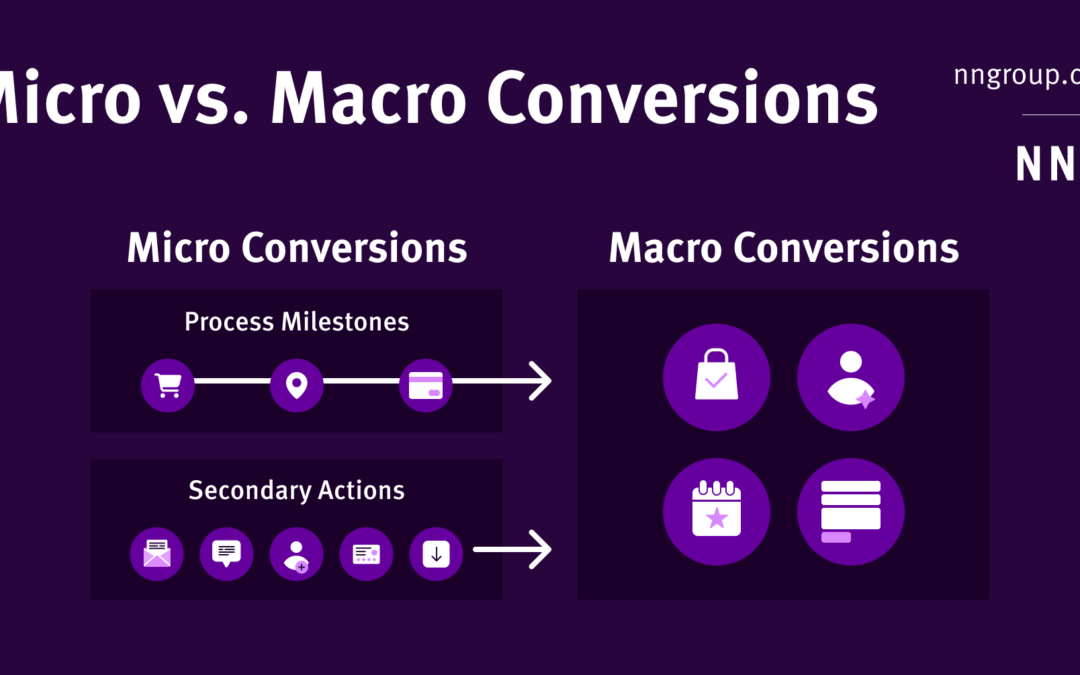Summary:
Macro conversions are desired user actions that directly contribute to your business’s primary goals. In contrast, micro conversions are user actions that precede macro conversions and occur more frequently.
Product managers and digital marketing professionals want to convert visitors into customers who make purchases, submit information, or complete specific actions on their platforms. The term “conversion” refers to a user action that aligns with business goals. In other words, it’s the desired outcome you hope to achieve with your digital product.
Macro conversions are customer actions directly related to business goals, while micro conversions are small steps leading up to these goals. Understanding the difference between macro and micro conversions can help you optimize your product for success.
Macro Conversions
Conversion rates are key performance indicators (KPIs) used by businesses to measure the success of their products. They measure how often certain desired user actions (i.e., conversions) happen.
The most impactful conversions are known as macro conversions. Site owners often track one or few macro conversions that directly align with the site’s primary goals.
A macro conversion is a desired user action that directly contributes to the primary goals of your business.
|
Examples of Macro Conversions |
|
|
Product Purpose |
Macro Conversion |
|
Sell products/services |
Completed purchase |
|
Collect sales leads |
Submitted lead form |
|
Promote events |
Completed registration for event |
|
Build a social community |
Account created |
Conversions are often associated with collecting money (e.g., purchases and subscriptions), but they aren’t always. For example, creating a new account is considered a macro conversion for a product aiming to build a community. Preparing and filing their taxes is a macro conversion on a government site. Nonmonetary conversions are discussed in more detail at the end of the article.
Defining Your Macro Conversions
Defining macro conversions for your product begins with thinking about the overarching goals your company aims to achieve with that product. Assess how your product contributes to these overarching goals and which action users must take for this.
Once the necessary user actions are defined, your team should choose appropriate metrics to determine whether users are taking these actions. These metrics will allow you to track the success of your product over time.
Micro Conversions Allow for Granular Tracking
While the rate of macro conversions is a great measure of product performance, only few users will perform a macro conversion. Across several industries, the average macro-conversion rate is only 2.9%.
Additionally, users might go through an extensive cycle of consideration, research, and preparation until they eventually decide to perform a macro conversion. Thus, macro-conversion rates may be slow to change, which makes it challenging to assess the success of incremental improvements made to a product.
To granularly measure the success of product improvements, you can use micro conversions.
Micro conversions are actions that are indirectly related to KPIs but that tend to happen more frequently.
|
Example Micro Conversions |
|
|
Product Purpose |
Micro Conversions |
|
Selling products |
Adding a product to cart Starting the checkout flow |
|
Collect sales leads |
Visiting the lead-form page Subscribing to a newsletter |
|
Promote events |
Visiting event-information page Downloading an event app |
|
Build a social community |
Visiting the platform without creating an account Downloading the app |
There are two types of micro conversions: process milestones and secondary actions.
Process-Milestone Micro Conversions
Process milestones are the critical, most common steps users take on the path to a macro conversion. They represent the stages of the most likely user journey toward a macro conversion and can help us identify where users are dropping off.
Process-milestone micro conversions are conversions that represent linear movement toward a macro conversion.
Process milestones allow us to track whether and how users move toward a macro conversion. They are especially helpful when analyzing the impact of incremental design improvements that might not have an immediate significant impact on the macro conversion.
Defining Your Process Milestones
To identify which process milestones to track on your website, leverage existing information such as customer-journey maps or analytics data. These resources can help you analyze which of the steps users commonly take signal that they are moving closer to a macro conversion.
Alternatively, walk through your product as if you were a user and assess which actions indicate progress toward a macro conversion. These could include points where users must overcome friction on their journey. For example, confirming the email addresses to move ahead with creating an account would be a process milestone toward successful account creation.
Secondary-Action Micro Conversions
Macro conversions that require significant user commitment are often preceded by a series of desirable actions that build trust and loyalty across sessions. While these actions may not be necessary or even common steps users perform before a macro conversion, they may still be highly desirable from the company’s perspective and might predict future macro conversions.
Secondary-action micro conversions are micro conversions that do not directly lead up to a macro conversion but may predict future macro conversions.

Secondary actions are highly contextual and will vary based on the website’s goals, design, and features.
|
Common Secondary Actions that Can Serve as Micro Conversions |
|
|
Content Interaction and Engagement |
Personalization and Filtering |
|
|
Defining Your Secondary Actions
To define secondary actions for your product, consider desirable user actions that, even though they may not directly lead to a macro conversion, indicate increased engagement with your product or a strong connection to your brand. Users performing these actions might not be on a direct path toward a macro conversion but will be likely to get there in the future.
Conversions for Products with Nonmonetary Goals
Many UX professionals struggle to apply the concepts of macro and micro conversion to websites or products with nonmonetary goals, such as intranets, software, social media platforms, online forums, or educational sites.
It is often challenging to clearly define the primary business goals for these products and, therefore, challenging to define which user actions directly contribute to these goals.
To understand how to apply the concepts of macro and micro conversion in these scenarios, you must differentiate between two types of user actions: mandatory and optional actions.
Mandatory User Actions
Conversion rates are not suitable for evaluating how users perform mandatory actions, which are actions where users have no alternatives. To assess the performance of your design for these mandatory actions, collect instead metrics such as ease of use, error counts, and customer-support interactions.
For instance, consider the process of employees requesting vacation time through the company’s intranet. In this scenario, measuring conversion rates is not helpful because the number of vacation requests will remain constant regardless of design changes. Employees are forced to use the intranet for vacation requests, no matter how easy or complicated the process is, as they have no other alternative.
Optional User Actions
When users have the choice to perform a certain action, or there are multiple ways to perform this action, conversion rates can be an effective tool for understanding user behavior and assessing the impact of design improvements.
For example, let’s assume that an intranet promotes a nonmandatory company event that requires signing up. If employees can sign up either via a paper form or through the intranet, the conversion rate for intranet signups can provide valuable insights into how well the event was promoted through the intranet.
However, even when user actions are optional, it can still be challenging to define macro conversions for products with nonmonetary goals, as there might not be any user actions that directly contribute to the company’s primary business goals. Instead, there might be many actions that have some positive impact. These optional actions are essentially secondary actions for your product, and you can track conversion rates for them.
|
Examples of Micro Conversions for Products with Nonmonetary Goals |
|
|
Product Purpose |
Micro Conversion |
|
Promote a nonmandatory event |
Completed registration for event |
|
Provide free documents |
Document downloaded |
|
Facilitate internal communication |
Message sent |
|
Provide free information (articles/videos) |
Article page visited/ video watched |
Additionally, it can be beneficial to track process milestones for these conversions, even if they are no macro conversions, as that data can provide insights into user behavior leading up to these conversions and changes to it over time.
Conclusion

Leveraging the concepts of macro and micro conversion can help you understand how your design contributes to your organization’s primary goals. These insights will allow you to refine your design approach and calculate the return on investment (ROI) of your project, effectively proving the value of your UX work to your stakeholders.






